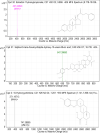Phytochemical analysis, in vitro and in silico effects from Alstonia boonei De Wild stem bark on selected digestive enzymes and adipogenesis in 3T3-L1 preadipocytes
- PMID: 37864233
- PMCID: PMC10588189
- DOI: 10.1186/s12906-023-04202-6
Phytochemical analysis, in vitro and in silico effects from Alstonia boonei De Wild stem bark on selected digestive enzymes and adipogenesis in 3T3-L1 preadipocytes
Erratum in
-
Correction: Phytochemical analysis, in vitro and in silico effects from Alstonia boonei De Wild stem bark on selected digestive enzymes and adipogenesis in 3T3‑L1 preadipocytes.BMC Complement Med Ther. 2023 Oct 28;23(1):389. doi: 10.1186/s12906-023-04236-w. BMC Complement Med Ther. 2023. PMID: 37898774 Free PMC article. No abstract available.
Abstract
Background: Obesity is a global health issue arising from the unhealthy accumulation of fat. Medicinal plants such as Alstonia boonei stem bark has been reported to possess body weight reducing effect in obese rats. Thus, this study sought to investigate the in vitro and in silico effects of fractions from Alstonia boonei stem bark on selected obesity-related digestive enzymes and adipogenesis in 3T3-L1 preadipocytes.
Method: Two fractions were prepared from A. boonei: crude alkaloid fraction (CAF) and crude saponin fraction (CSF), and their phytochemical compounds were profiled using Liquid chromatography with tandem mass spectrometry (LCMS/MS). The fractions were assayed for inhibitory activity against lipase, α-amylase and α-glucosidase, likewise their antiadipogenic effect in 3T3-L1 adipocytes. The binding properties with the 3 enzymes were also assessed using in silico tools.
Results: Eleven alkaloids and six saponin phytochemical compounds were identified in the CAF and CSF using LCMS/MS. The CAF and CSF revealed good inhibitory activity against pancreatic lipase enzyme, but weak and good activity against amylase respectively while only CSF had inhibitory activity against α-glucosidase. Both fractions showed antiadipogenic effect in the clearance of adipocytes and reduction of lipid content in 3T3-L1 adipocytes. The LCMS/MS identified compounds (41) from both fractions demonstrated good binding properties with the 3 enzymes, with at least the top ten compounds having higher binding energies than the reference inhibitors (acarbose and orlistat). The best two docked compounds to the three enzymes were firmly anchored in the substrate binding pockets of the enzymes. In a similar binding pattern as the reference acarbose, Estradiol-17-phenylpropionate (-11.0 kcal/mol) and 3α-O-trans-Feruloyl-2 α -hydroxy-12-ursen-28-oic acid (-10.0 kcal/mol) interacted with Asp197 a catalytic nucleophile of pancreatic amylase. Estradiol-17-phenylpropionate (-10.8 kcal/mol) and 10-Hydroxyyohimbine (-10.4 kcal/mol) interacted with the catalytic triad (Ser152-Asp176-His263) of pancreatic lipase while Estradiol-17-phenylpropionate (-10.1 kcal/mol) and 10-Hydroxyyohimbine (-9.9 kcal/mol) interacted with Asp616 and Asp518 the acid/base and nucleophilic residues of modelled α-glucosidase.
Conclusion: The antiobesity effect of A. boonei was displayed by both the alkaloid and saponin fractions of the plant via inhibition of pancreatic lipase and adipogenesis.
Keywords: Alkaloid; Alstonia boonei; Amylase; Lipase; Obesity; Saponin.
© 2023. The Author(s).
Conflict of interest statement
The authors declare no competing interests.
Figures





References
-
- World Health Organization . Report of the commission on ending childhood obesity. Geneva: World Health Organization; 2000.
-
- Pedrosa MR, Franco DR, Gieremek HW, Vidal CM, Bronzeri F, de Cassia RA, de Carvalho Cara LG, Fogo SL, Eliaschewitz FG. GLP-1 agonist to treat obesity and prevent cardiovascular disease: what have we achieved so far? Curr Atheroscler Rep. 2022;24(11):867–884. doi: 10.1007/s11883-022-01062-2. - DOI - PubMed
MeSH terms
Substances
Grants and funding
LinkOut - more resources
Full Text Sources

